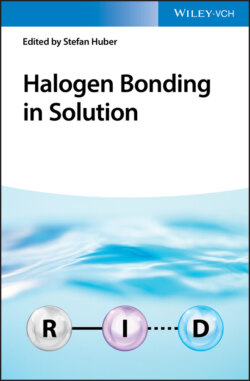Читать книгу Halogen Bonding in Solution - Группа авторов - Страница 15
1.1.4 Solid‐state Halogen Bond Contacts
ОглавлениеHalogen bond interactions in the solid state are typically quantified by their contact distance and angle with a Lewis base and described using the R–X⋯Y notation. Additionally, halogen bond contacts are often reported along with a percentage of their combined van der Waals (vdW) radii or more frequently a ratio. The ratio has been given various names such as the halogen bond interaction ratio, normalized interaction distance, normalized contact, or reduction ratio. The ratio is generally defined as where dXA is the measured distance (Å) from the halogen donor (X) to the acceptor (A), divided by the sum of the vdW radii (Å) of X and A (XvdW + AvdW). The ratio notation RXA further informs the reader, as X is replaced with the atomic symbol of the halogen bond donor, while A denotes the atomic symbol of the halogen bond acceptor atom. For example, RBrO indicates a halogen bond between a bromine donor and an oxygen acceptor. Reporting this ratio enables quick comparison of distances between different halogen bonding sites; yet, it is important to specify the vdW values used as radii can differ based on the sources referenced [9]. Smaller ratio values typically indicate strong halogen bond interactions. When contacts involve anionic Lewis bases, some utilize ionic radii values [10], while others employ vdW radii. Presently, there seems to be no “industry standard,” and simply reporting which values are used is the best practice.
Table 1.1 Common halogen bond donors and acceptors.
Source: From Desiraju et al. [2]. © IUPAC.
| Common RX species | Dihalogen molecule (e.g. I2, Br2, ICl, ClF)Haloalkane (e.g. CBr4, CHI3, CnF2n+1I)Haloarene or heteroarene (e.g. iodobenzene, halopyridinium, and haloimidazolium cations)1‐Haloalkyne (e.g. diiodoacetylene)Halonium ion (e.g. diphenyliodonium or bromonium derivatives)Haloimide (e.g. N‐bromo‐ or N‐iodosuccinimide) |
| Common Y species | Lone pair possessing atom (e.g. N atom of pyridine or an amine, O atom of a carbonyl group) π‐System (e.g. double or triple bonds, arene moiety) Anion (e.g. halides, oxyanions) |
